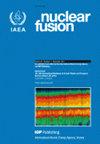Resistive wall tearing mode disruptions
IF 4
1区 物理与天体物理
Q1 PHYSICS, FLUIDS & PLASMAS
引用次数: 0
Abstract
This paper deals with resistive wall tearing mode (RWTM) disruptions. RWTMs are closely related to resistive wall modes. RWTMs are tearing modes whose linear and nonlinear behavior is strongly dependent on the resistive wall outside the plasma. The consequence for ITER, is that the thermal quench timescale could be much longer than previously conjectured. Active feedback stabilization is another possible way to mitigate or prevent RWTM disruptions. Simulations of RWTM disruptions are reviewed for DIII-D and MST. MST has a longer resistive wall time than ITER, and disruptions are not observed experimentally when MST is operated as a standard tokamak. Simulations indicate that the RWTM disruption time scale is longer than the experimental shot time. Edge cooling causes contraction of the current profile, which can destabilize RWTMs. The equilibria studied here have the阻力墙撕裂模式中断
本文涉及阻性墙体撕裂模式(RWTM)破坏。RWTM 与电阻壁模式密切相关。RWTM 是一种撕裂模式,其线性和非线性行为与等离子体外的电阻壁密切相关。这对热核实验堆的影响是,热淬火的时间尺度可能比之前推测的要长很多。主动反馈稳定是减轻或防止 RWTM 干扰的另一种可能方法。对 DIII-D 和 MST 的 RWTM 干扰模拟进行了回顾。MST 的阻力壁时间比热核实验堆更长,而且当 MST 作为标准托卡马克运行时,在实验中没有观察到中断现象。模拟结果表明,RWTM 的中断时间尺度长于实验射出时间。边缘冷却会导致电流曲线收缩,从而破坏 RWTM 的稳定。本文研究的平衡状态是 q = 2 理性表面靠近等离子体边缘,q = 2 表面和壁之间的电流密度较低。一连串的低边缘电流模型平衡只有在电阻壁(而非理想壁)和边缘 q⩽3.4 时才会出现严重破坏。这与托卡马克的破坏性是一致的,表明在低边缘q时由边缘冷却引起的托卡马克破坏可能是RWTMs。
本文章由计算机程序翻译,如有差异,请以英文原文为准。
求助全文
约1分钟内获得全文
求助全文
来源期刊

Nuclear Fusion
物理-物理:核物理
CiteScore
6.30
自引率
39.40%
发文量
411
审稿时长
2.6 months
期刊介绍:
Nuclear Fusion publishes articles making significant advances to the field of controlled thermonuclear fusion. The journal scope includes:
-the production, heating and confinement of high temperature plasmas;
-the physical properties of such plasmas;
-the experimental or theoretical methods of exploring or explaining them;
-fusion reactor physics;
-reactor concepts; and
-fusion technologies.
The journal has a dedicated Associate Editor for inertial confinement fusion.
 求助内容:
求助内容: 应助结果提醒方式:
应助结果提醒方式:


